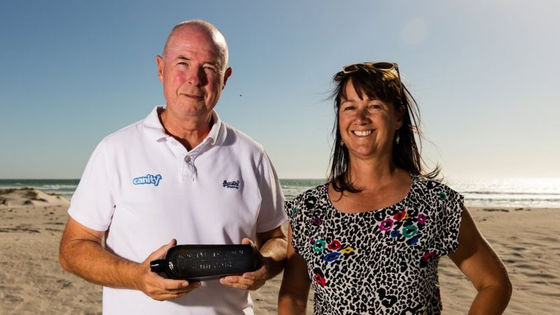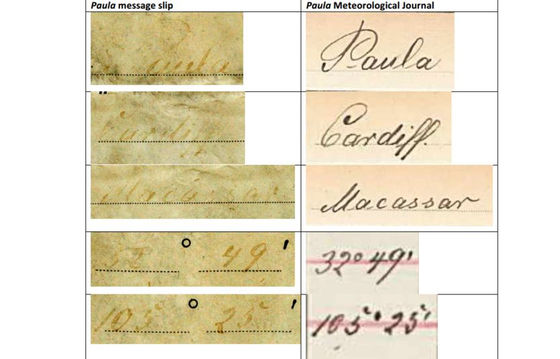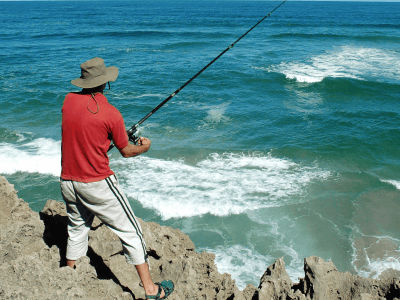Letters sent in bottles long before 130 years are found

Tonya Ilmann, who was strolling through the sand dunes near the beach in Western Australia, found an old bottle. When I opened the inside of the bottle, it seemed that there was wet paper inside, and when I went back home and dried using an oven, it was obvious that this was a letter shed in a bottle long ago became. After that, when asked by experts, this letter proved to be a letter which was let down from a German ship more than 130 years ago.
Oldest message in a bottle found on Western Australia beach - BBC News
http://www.bbc.com/news/world-australia-43299283
132 year old message in a bottle found on WA beach | Western Australian Museum
http://museum.wa.gov.au/about/latest-news/132-year-old-message-bottle-found-on-wa-beach
According to experts, the bottle discovered by Tonya Ilmann by chance contains banknotes dated June 12, 1886. As part of the experiment the German Navy Observatory had done on the maritime transport route, the German ship " It seems to have been thrown into the sea from Paula. In the "letter in a bottle", since "the period from being bottled to being opened" was the longest in "108 years", newly discovered in Western Australia is new It is highly likely that it will be certified as Guinness World Record.

Tonya Ilmann and her husband Kim Ilmann said that they were running cars on the beach on the western side of Western Australia's western island on January 21, 2018. Because the tire has been taken off by the beach sand, Illuman couple and their sons and girlfriends decide to go out for a walk with their cars. In an interview with BBC, Mr. Kim looks back on what was happening when he discovered the bottle, "Tonya was thinking that lots of garbage is falling on the ground and thought about picking up garbage."
And Mr. Tonya finds a nice bottle just to decorate it on the bookshelf in picking up garbage. Tonya seems to have handed the bottle to his son 's girlfriend, then the girlfriend discovers objects like cigarettes in a bottle. Tonya immediately drops the sand of the bottle, takes out objects like paper from inside and tries to unwind the thread wrapped around this paper. However, since the paper suffered from water and it was in a state that it was pretty easy to break, I took the bottle once at the bottle and put the paper in the oven for about 5 minutes to fly moisture.

At this point it seems that ink was almost invisible on paper, but in the bottle there are cards printed with "I will contact the German consular office if I find a letter", and " June 12, 1886 "and the name of the ship were faintly read, and it seems that it was found that the bottle and the letter were thrown to the sea a long time ago. Although I thought that Mr. Kim was "too old," I decided to check the internet and bring a bottle to a specialist at the Western Australian Museum.
Dr. Ross Anderson working at the Western Australian Museum considers that with the experts from Germany and the Netherlands, we conclude that the bottle is the real "132 years ago". "Incredibly in the German archive search, a navigational diary with pola's weather information at that time was found, and on 12 June 1886 the captain threw it into the sea from the ship and that date · The coordinates are revealed, "Dr. Anderson says.
The following picture is a note written on the letter that was in the bottle on the left, and a memo on the right was written in the navigation diary of Paula. The top is the name of the ship "Paula (Paula)", the bottom is the starting place of Paula of the time "Cardiff (Cardiff)".

Experts commented, "The ship put the bottle in the southeastern part of the Indian Ocean on the way to Cardiff from Wales to Indonesia, the bottle was likely to be stranded to the coast of Australia within 12 months, buried under the sand It is said.
Germany has been doing experiments throwing a bottle containing letters from the ship to the sea for 69 years, during which thousands of bottles have been thrown away. The bottles discovered so far were 662 bottles, the bottles recently discovered were those found in Denmark in 1934. A bottle discovered on Wedge Island was discovered in a state where the cork and other stoppers were not closed, and it seems that a lot of wet sand was contained in it.
The Iluman couple will rent the bottles and letters they discover to the Western Australian Museum for 2 years and will be exhibited in the museum since March 2018.
Related Posts:
in Note, Posted by logu_ii







